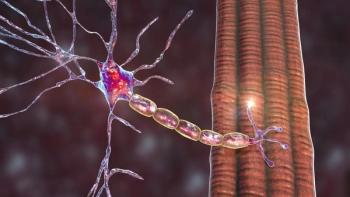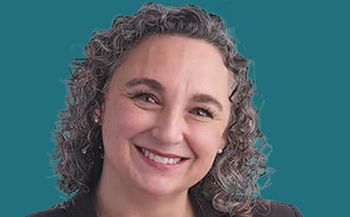
Bispecific Antibodies Effective After CAR T-Cell Relapse in Myeloma?
Oliver Van Oekelen, MD, MSc, resident and PhD student, Icahn School of Medicine, Mount Sinai, discussed findings from a retrospective study.
This content originally appeared on our sister site,
Researchers examined patients with relapsed or refractory multiple myeloma who developed disease progression after BCMA-directed CAR T-cell therapy and found an overall response rate (ORR) of 45% with subsequent first-line salvage therapy in this population.
These findings, from a retrospective study, were presented at the 2021 ASH Annual Meeting and Exposition. Oliver Van Oekelen, MD, MSc, resident, internal medicine and PhD student, Icahn School of Medicine, Mount Sinai, discussed these findings.
He discussed how novel agents, including bispecific antibodies, demonstrated encouraging responses in patients with multiple myeloma who relapsed on BCMA-directed CAR T-cell therapy, and how this provides insight into a setting in which little is known about treatment sequencing.
“There are good options for patients with myeloma who are highly refractory and who relapse after BCMA-directed CAR T-cell therapy,” Van Oekelen said. “Depending on the profile of the patient, we should try to offer them options, such as T-cell engagers, combination chemotherapy, as well as combination regimens with novel agents.” - Oliver Van Oekelen, MD, MSc
OncLive®: What served as the rationale for this analysis?
Van Oekelen: In multiple myeloma, we recently received the approval of idecabtagene vicleucel [ide-cel; Abecma], a BCMA-directed CAR T-cell therapy, and other CAR T-cell therapies are under development and will be approved soon.* Sadly, most patients, even though the CAR T-cell therapies are highly effective, relapse at some point.
An important outstanding question now is: How are we going to approach patients who relapse after BCMA-directed agents whether that’s CAR T-cell therapy, bispecific antibodies, or antibody-drug conjugates [ADCs]? We had the opportunity to look at patients who were treated on a BCMA-directed CAR T-cell therapy trial at Mount Sinai. Specifically, how these patients were treated and how they did after their relapse on the trial.
Could you describe the patient population that was included in the analysis?
In total, [77] patients were treated with BCMA-directed CAR T-cell therapy. These patients came from several studies and were treated with different CAR T-cell therapies but mostly [ide-cel] and ciltacabtagene autoleucel [cilta-cel; Carvykti].
As the starting date for our analysis, we took the date when the patient relapsed on the therapy. Although it was relatively rare, a handful of patients received a second infusion of CAR T-cell therapy. In that case, we considered the date of relapse after the reinfusion as the start date for our analysis. A total of 34 patients had relapsed.
[Those 34 patients] were part of the data set that we’re studying and expanding over time as more patients relapse. We looked at clinical characteristics and the treatments that they received, and in many cases, patients received multiple lines of therapy. Then we looked at the efficacy of those treatment regimens to see which were associated with the best responses.
What stood out about the findings?
The bottom line in terms of results is the fact that there is life after CAR T-cell therapy and that there are options for patients who relapse. A big concern was: What does the clinical outcome look like in terms of progression-free survival or overall survival [OS]? In the study, we found that the first line of therapy after CAR T-cell therapy was associated with an ORR of 45%. That means that half of the patients [who relapsed] had a response to the first subsequent treatment that was tried. The treatment options that were explored most were bispecifics in clinical trials and combination chemotherapy regimens, such as DCEP [dexamethasone, cyclophosphamide, etoposide, cisplatin] or similar regimens, with or without stem cell boosts to account for cytopenias.
It turns out [that bispecifics] showed efficacy in a [respectable] number of patients, suggesting that, for example, the option of bispecific therapy after CAR T-cell relapse is something to explore for patients who are eligible for this therapy.
We also wanted to look at OS, because we have data from historical cohorts, suggesting that patients who are triple-class refractory or penta-refractory have poor survival outcomes. It was hopeful to see that patients who relapsed after CAR T-cell therapy had an OS that was relatively long. It was reassuring to see that patients after their relapse on CAR T-cell therapy in our data set had an OS of about 15 months.
That means that there are options that we can offer them, and that some patients have durable responses. The most durable responses were seen in patients treated with T-cell engagers, such as bispecifics, and we’re excited to explore that further.
An important limitation of our study is that all the patients that we evaluated were those enrolled on a clinical trial. As the therapy becomes available to patients commercially, it’s important to keep studying whether these results also translate to the general myeloma population.
Reference
Van Oekelen O, Mouhieddine TH, Pan D, et al. Clinical outcomes and treatment strategies for relapsed/refractory myeloma patients after relapse on BCMA-targeted CAR T. Blood. 2021;138(suppl 1):2704. doi:10.1182/blood-2021-152243
*Editor’s Note: This interview took place prior to the February 28, 2022, FDA approval of cilta-cel for the treatment of adult patients with relapsed/refractory multiple myeloma following 4 or more prior lines of therapy, including a proteasome inhibitor, an immunomodulatory agent, and an anti-CD38 monoclonal antibody.
Newsletter
Stay at the forefront of cutting-edge science with CGT—your direct line to expert insights, breakthrough data, and real-time coverage of the latest advancements in cell and gene therapy.











































